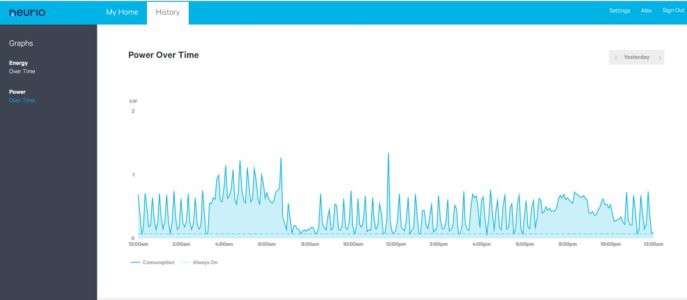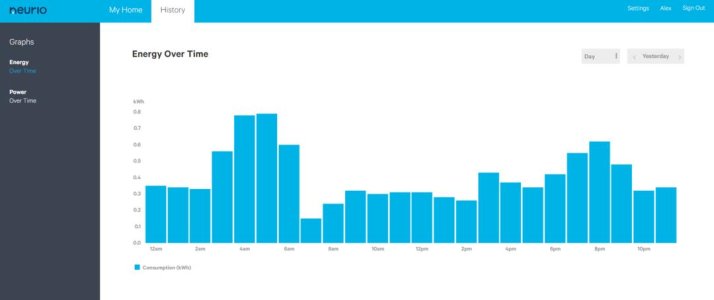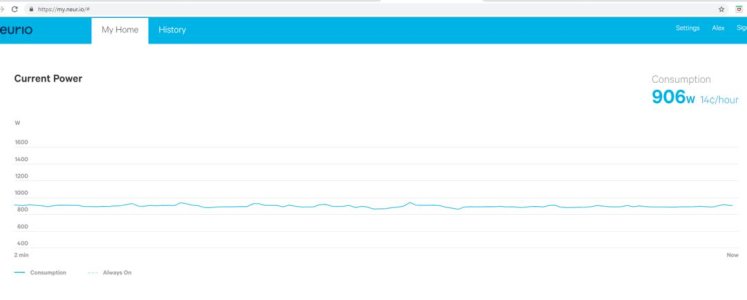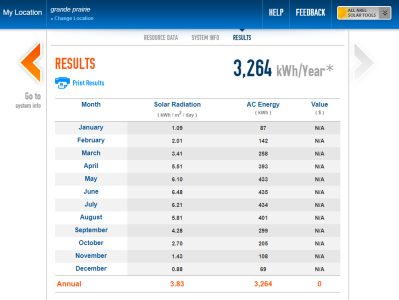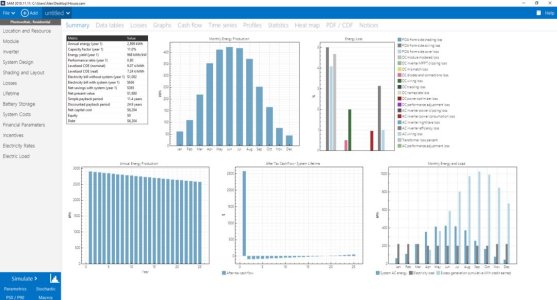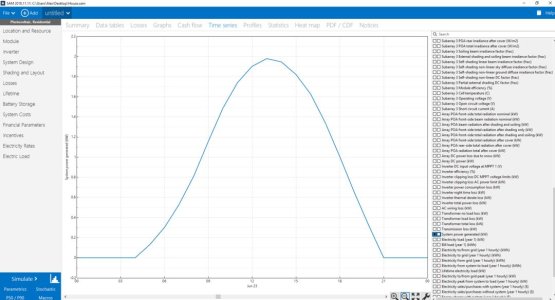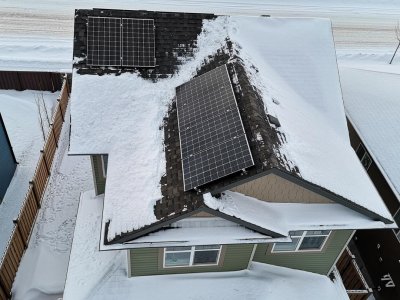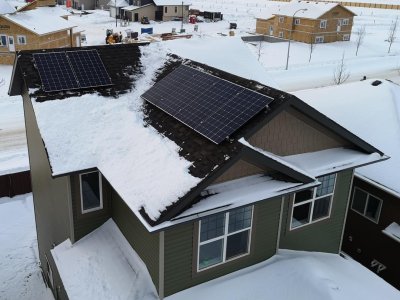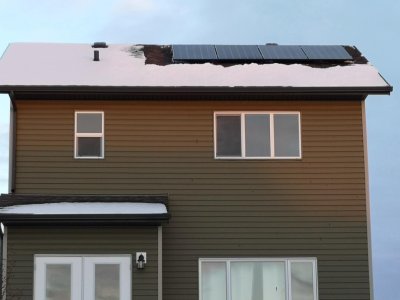ABMax24
Active VIP Member
With the topic of renewable/alternative energy being front and center the last few years I've decided to post a thread on our Grid-Tied Solar System Install.
My motives for this install are mostly based on intrigue and the eventual return on investment through net metering.
Here we go...
Energy Efficiency:
I'd like to point out that if others are looking at doing this to save money on their power bill a far better return on investment is provided by reducing consumption in the first place. To that end we have done many things to reduce our electricity consumption first. Our house was built in 2014 so our walls are built with ~R-20 insulation, our furnace is a 95% efficient natural gas condensing type, we have a 95% efficient natural gas on demand hot water heater. When we moved in the house was new and came with no appliances, I installed gas lines to everything I could to avoid using electricity for heating appliances, our stove, BBQ, clothes dryer, and garage heater are all natural gas fired. Using electricity for heating is extremely costly, electric heat costs about 5 times more per unit of energy compared with natural gas. We also replaced every light bulb in the house with an LED equivalent.
After all these upgrades we end up using almost exactly 2600kwh of electricity per year. I would estimate we use about 30%-40% less electricity with the gas appliances and LED bulbs compared to if we had used an electric stove, dryer and kept the incandescent bulbs. I unfortunately don't have an actual base line to base this on so this is an educated guess. All in it cost us about another $1000 to go with these appliances compared to the standard electric ones, this includes the extra cost of the appliance and the cost of materials for the gas line and the gas permit. I didn't include the cost of gas line install as I did this myself.
The average Alberta household uses 7200kwh of electricity per year, and 120GJ of natural gas. We use 2600kwh of electricity and 84 GJ of natural gas. Therefore we use 36% of the electricity and 70% of the natural gas compared to the provincial average.
Solar System Specs:
In the Province of Alberta Grid Tied Solar Systems are covered under the Micro-Generation Legislation, this gives every home owner the right to generate up to 100% of their annual consumption in renewable energy. Grid tied meaning that we still have an electrical connection to the main grid, so any power we can't produce we will buy from the grid, and any extra that we can't use gets sold to the grid. I'll cover the financial compensation scheme for this in a later post.
Considering our small electricity consumption our system will be correspondingly small, but given the above information we are sizing to produce 100% of the energy we use on an annual basis. Our system will be 3kw, it will consist of 10 300 watt Trina Solar panels and 5 APSystems YC600 MicroInverters. We don't have a large enough south facing roof to install all 10 panels in a south facing direction, so instead I have opted to have 3 smaller arrays installed.
I will have 2 panels facing east to catch the morning sun, 4 panels south facing to catch the mid-day sun, and 4 panels facing west to catch the evening sun. I put more on the west side because we use more power in the evenings and want to have more self-consumption at that time (again I will cover more on this in the financial section).
These micro-inverters will each run 2 panels, each panels is on its separate MPPT (Maximum Power Point Tracking) circuit which makes the system more efficient. This maximizes the output of every single panel, so a shaded panel does not reduce the production of the others. MPPT effectively keeps the panel in its volt-amp curve sweet spot to maximize power output. Compare this to a string inverter where the panels are wired in 8-16 panels series strings to multiply the voltage to the string inverter. When one panel is shaded it then acts like a resistor lessening the output of the other panels, and also creating hot spots in the shaded panel due to the heat produced by a current flowing through the resistance.
After the inverters the electrical system becomes quite simple, the output of all 3 arrays will be combined to a single cable where it is fed from the roof and down a return air chase to the breaker panel in the basement.
As a part of this we need a bi-directional meter installed on the house so ATCO can meter both the energy we consume and the energy we sell back to the grid.
Progress:
As it stands right now we already selected the contractor to perform the install and paid our deposit. The structural engineering for the roof has been completed to ensure the roof can support the panels. The City has granted us building and electrical permits for the install. The contractor has ordered and received the solar panels, inverters, and other components to complete the install. The electrical boxes and mounts for the panels have also been installed.
Yet to do:
The electrical cable from the roof to the panel has yet to be run
The rails need to be installed on the mounts
The panels need to be installed on the rails
Tie in the above components to each other to make it work
The above is all supposed to happen this Friday and Saturday
We also need to receive the net metering contract from ATCO so we can have the bi-directional meter installed.
As well as a final inspection from electrical and building inspectors once the install is complete.
Upcoming Posts:
I don't have enough time at once to post all my information on this, but here is what I intend to add:
Financial information: cost of install, rebates, how net-metering works, payback and rates of return
Calculated performance data
Energy monitoring: the system I use and how it works
Actual performance data of the system over time
Installation Pictures
Links to detailed spec sheets on solar components
I will try to post updates as time allows.
Please feel free to ask any questions you have, I will try answer the best I can.
My motives for this install are mostly based on intrigue and the eventual return on investment through net metering.
Here we go...
Energy Efficiency:
I'd like to point out that if others are looking at doing this to save money on their power bill a far better return on investment is provided by reducing consumption in the first place. To that end we have done many things to reduce our electricity consumption first. Our house was built in 2014 so our walls are built with ~R-20 insulation, our furnace is a 95% efficient natural gas condensing type, we have a 95% efficient natural gas on demand hot water heater. When we moved in the house was new and came with no appliances, I installed gas lines to everything I could to avoid using electricity for heating appliances, our stove, BBQ, clothes dryer, and garage heater are all natural gas fired. Using electricity for heating is extremely costly, electric heat costs about 5 times more per unit of energy compared with natural gas. We also replaced every light bulb in the house with an LED equivalent.
After all these upgrades we end up using almost exactly 2600kwh of electricity per year. I would estimate we use about 30%-40% less electricity with the gas appliances and LED bulbs compared to if we had used an electric stove, dryer and kept the incandescent bulbs. I unfortunately don't have an actual base line to base this on so this is an educated guess. All in it cost us about another $1000 to go with these appliances compared to the standard electric ones, this includes the extra cost of the appliance and the cost of materials for the gas line and the gas permit. I didn't include the cost of gas line install as I did this myself.
The average Alberta household uses 7200kwh of electricity per year, and 120GJ of natural gas. We use 2600kwh of electricity and 84 GJ of natural gas. Therefore we use 36% of the electricity and 70% of the natural gas compared to the provincial average.
Solar System Specs:
In the Province of Alberta Grid Tied Solar Systems are covered under the Micro-Generation Legislation, this gives every home owner the right to generate up to 100% of their annual consumption in renewable energy. Grid tied meaning that we still have an electrical connection to the main grid, so any power we can't produce we will buy from the grid, and any extra that we can't use gets sold to the grid. I'll cover the financial compensation scheme for this in a later post.
Considering our small electricity consumption our system will be correspondingly small, but given the above information we are sizing to produce 100% of the energy we use on an annual basis. Our system will be 3kw, it will consist of 10 300 watt Trina Solar panels and 5 APSystems YC600 MicroInverters. We don't have a large enough south facing roof to install all 10 panels in a south facing direction, so instead I have opted to have 3 smaller arrays installed.
I will have 2 panels facing east to catch the morning sun, 4 panels south facing to catch the mid-day sun, and 4 panels facing west to catch the evening sun. I put more on the west side because we use more power in the evenings and want to have more self-consumption at that time (again I will cover more on this in the financial section).
These micro-inverters will each run 2 panels, each panels is on its separate MPPT (Maximum Power Point Tracking) circuit which makes the system more efficient. This maximizes the output of every single panel, so a shaded panel does not reduce the production of the others. MPPT effectively keeps the panel in its volt-amp curve sweet spot to maximize power output. Compare this to a string inverter where the panels are wired in 8-16 panels series strings to multiply the voltage to the string inverter. When one panel is shaded it then acts like a resistor lessening the output of the other panels, and also creating hot spots in the shaded panel due to the heat produced by a current flowing through the resistance.
After the inverters the electrical system becomes quite simple, the output of all 3 arrays will be combined to a single cable where it is fed from the roof and down a return air chase to the breaker panel in the basement.
As a part of this we need a bi-directional meter installed on the house so ATCO can meter both the energy we consume and the energy we sell back to the grid.
Progress:
As it stands right now we already selected the contractor to perform the install and paid our deposit. The structural engineering for the roof has been completed to ensure the roof can support the panels. The City has granted us building and electrical permits for the install. The contractor has ordered and received the solar panels, inverters, and other components to complete the install. The electrical boxes and mounts for the panels have also been installed.
Yet to do:
The electrical cable from the roof to the panel has yet to be run
The rails need to be installed on the mounts
The panels need to be installed on the rails
Tie in the above components to each other to make it work
The above is all supposed to happen this Friday and Saturday
We also need to receive the net metering contract from ATCO so we can have the bi-directional meter installed.
As well as a final inspection from electrical and building inspectors once the install is complete.
Upcoming Posts:
I don't have enough time at once to post all my information on this, but here is what I intend to add:
Financial information: cost of install, rebates, how net-metering works, payback and rates of return
Calculated performance data
Energy monitoring: the system I use and how it works
Actual performance data of the system over time
Installation Pictures
Links to detailed spec sheets on solar components
I will try to post updates as time allows.
Please feel free to ask any questions you have, I will try answer the best I can.
Last edited:



